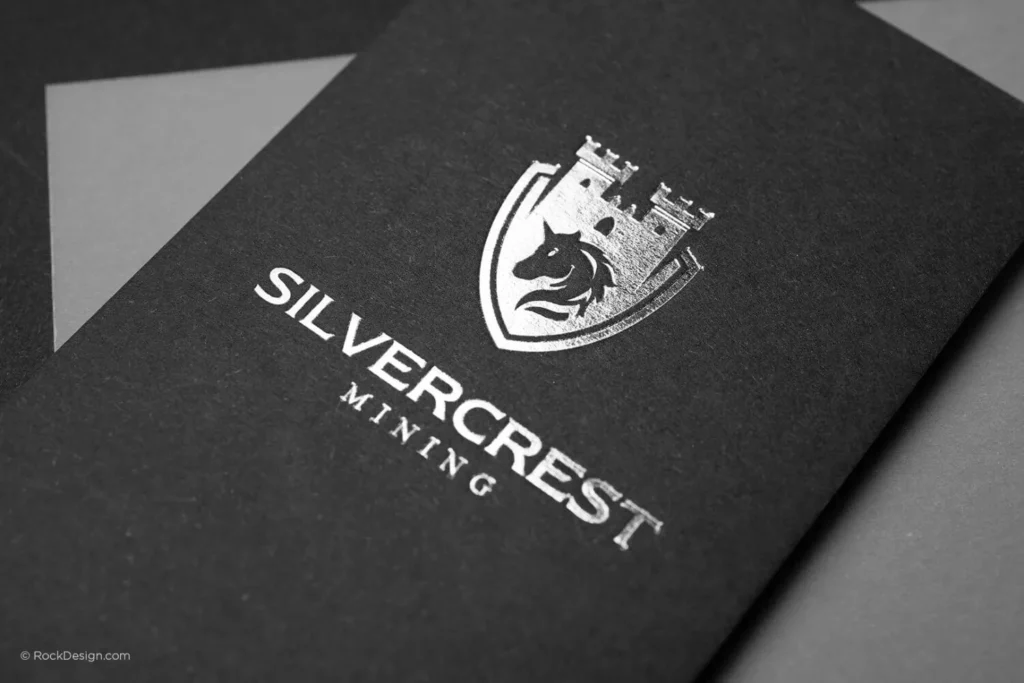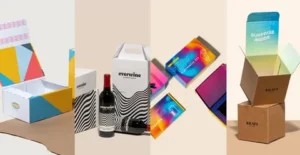Silver foiling is a technique used to apply a thin layer of silver onto surfaces. It adds a shiny and luxurious touch to various items like packaging, stationery, and more. It’s a popular choice for adding elegance and sophistication. Silver foiling, also known as silver stamping or silver leafing, is a process where a thin layer of silver is applied onto a surface. It involves using heat and pressure to transfer the silver foil onto the desired object.
The process starts with preparing the surface by ensuring it is clean and smooth. Then, a special adhesive, called foil sizing, is applied to the surface. Once the adhesive becomes tacky, the silver foil is carefully placed onto it and pressed down firmly. The heat and pressure help the foil adhere to the surface, creating a metallic and reflective effect. Silver foiling can be done on various materials such as paper, cardboard, leather, and even fabric. It is commonly used in packaging, invitations, business cards, and luxury goods to add a touch of elegance and sophistication. The silver foil can be applied to specific areas or cover the entire surface, depending on the desired design.
The advantages of silver foiling include its ability to create eye-catching and high-quality finishes, its durability, and its resistance to fading or tarnishing over time. However, it’s important to note that silver foiling can be more expensive compared to other decorative techniques, and it requires skilled craftsmanship to achieve precise and flawless results. I hope this provides a more detailed explanation of silver foiling! Let me know if you have any more questions.
Table of Contents
ToggleProcess of silver foiling:
The process of silver foiling is discussed below.
- Surface preparation: The surface to be foiled is cleaned and made smooth to ensure proper adhesion of the foil.
- Adhesive Application: A special adhesive, often referred to as foil sizing, is applied to the surface. This adhesive is designed to create a tacky surface that will bond with the foil.
- Foil Placement: The adhesive becomes tacky, and the silver foil is carefully placed onto the surface. It is important to handle the foil delicately to avoid tearing or wrinkling.
- Heat and Pressure: Heat and pressure are applied to the foil using a heated stamp or a hot foil press. This activates the adhesive and helps the foil adhere to the surface.
- Removal Of Excess Foil: After the foiling process, any excess foil is removed, leaving behind the desired foiled design.
- Finishing Touches: The foiled surface may be polished or buffed to enhance the shine and smoothness of the foil.
That’s a detailed explanation of the process of silver foiling! Let me know if you have any more questions or if there’s anything else I can help with.
Technique Used In Silver Foiling:
The technique of silver foiling in more detail. It involves a few key steps:
- Finishing Touches
- Removal Of Excess Foil
- Heat And Pressure
- Foil Placement
- Adhesive Application
That’s the technique of silver foiling in a nutshell!
List of Machines:
The machinery used in silver foiling is in more detail. There are a few key pieces of equipment involved:
- Foil Stamping Machine: This machine is commonly used for larger-scale foiling projects. It consists of a heated stamp or die that applies heat and pressure to the foil, transferring it onto the surface. The stamp can be customized with different designs or patterns.
- 2. Hot Foil Press: This is another type of machine used for silver foiling. It typically has a heated platen and a foil feed mechanism. The surface to be foiled is placed between the platen and the foil, and when the machine is activated, heat and pressure are applied to transfer the foil onto the surface.
- Foil Cutter: A foil cutter is a handy tool used to cut the silver foil into the desired size and shape before applying it to the surface. It ensures precise and clean cuts, allowing for accurate foiling.
- Foil Adhesive Applicator: This tool is used to apply the foil sizing or adhesive onto the surface. It can come in different forms, such as a brush, roller, or spray bottle, depending on the specific application method.
These are some of the main machinery and tools used in silver foiling. They help ensure precise and efficient application of the foil onto various surfaces.
Uses Of Silver Foiling:
Silver foiling has a wide range of uses across different industries. Here are some detailed examples:
- Packaging: Silver foiling is commonly used in packaging to enhance the visual appeal and create a luxurious look. It can be applied to boxes, bags, labels, and even wrapping paper, adding a touch of elegance to products and making them more enticing to customers.
- Printing Stationery: Silver foiling is often used in printing and stationery to create eye-catching designs. It can be applied to business cards, invitations, brochures, and letterheads, making them stand out and leaving a lasting impression on recipients.
- Branding And Marketing: Silver foiling can be a powerful branding tool. By incorporating it into logos, product labels, or promotional materials, businesses can elevate their brand image and make their products or services more memorable to consumers.
- Certificate And Awards: Silver foiling adds a sense of prestige and value to certificates and awards. Whether it’s academic certificates, achievement awards, or recognition plaques, the addition of silver foil enhances their perceived importance and makes them more visually appealing.
- Book Covers And Publishing: Silver foiling can be used on book covers to create an eye-catching and elegant design. It adds a layer of sophistication and makes the book more visually appealing on store shelves or online platforms.
- Luxury Goods: Silver foiling is often found on luxury goods such as designer bags, wallets, and accessories. The silver foil accents elevate the overall aesthetic and communicate a sense of exclusivity and quality.
These are just a few examples of the diverse uses of silver foiling. Its ability to enhance packaging, printing, branding, and luxury goods makes it a popular choice in various industries.
Purpose of Silver Foiling:
Sure, let me explain in detail the purpose of silver foiling. Silver foiling serves several purposes across different industries:
- Visual Enhancement: Silver foiling adds a touch of elegance, sophistication, and visual appeal to various products and materials. It catches the eye and creates a luxurious and premium look, making the item stand out from others.
- Branding and Marketing: The use of silver foiling in branding and marketing helps businesses create a strong and memorable brand image. By incorporating silver foiling into logos, packaging, or promotional materials, companies can convey a sense of quality, exclusivity, and professionalism.
- Product Differentiate: Silver foiling can be used strategically to differentiate a product from its competitors. By applying silver foiling to specific areas or details, companies can highlight unique features, create a sense of exclusivity, and attract customers.
- Prestige And Perceived Value: Silver foiling is often associated with high-end and luxury products. Its use on packaging labels or certificates adds a perceived value to the item, making it appear more prestigious and desirable.
- Attentin-grabbing: The reflective properties of silver foiling make it highly effective at catching attention. Whether it’s on book covers, invitations, or product labels, the shimmering effect of silver foiling draws people’s gaze and generates interest.
- Personalization and Customization: Silver foiling can be customized with different designs, patterns, or text, allowing for personalization. This customization adds a unique touch to products, making them more special and tailored to individual preferences.
Overall, the purpose of silver foiling is to enhance visual appeal, elevate brand image, differentiate products, and create a sense of prestige and value. Its versatility and eye-catching properties make it a popular choice in various industries.
Advantages of silver Foiling:
The advantages of silver foiling:
- Visual Appeal: Silver foiling adds a touch of elegance and sophistication to products. It catches the eye with its shiny and reflective surface, making the item visually appealing and attractive.
- Brand Enhancement: The use of silver foiling in branding helps businesses create a strong and memorable brand image. It adds a premium and luxurious feel to logos, packaging, or promotional materials, making the brand stand out and leave a lasting impression on customers.
- Differentiation: Silver foiling can set products apart from competitors. By incorporating silver foiling in specific areas or details, companies can create a unique and distinctive look that helps their products stand out on store shelves.
- Perceived Value: Silver foiling is often associated with high quality and exclusivity. Its use on packaging or labels can elevate the perceived value of a product, making it appear more prestigious and desirable to customers.
5 Attention-Grabbing:
The reflective properties of silver foiling make it highly effective at catching attention. Whether it’s on book covers, invitations, or product labels, the shimmering effect of silver foiling draws people’s gaze and generates interest, increasing the likelihood of customers noticing and engaging with the product.
- Customization: Silver foiling can be customized with different designs, patterns, or text, allowing for personalization. This customization adds a unique touch to products, making them more special and tailored to individual preferences.
- Durability: Silver foiling is a durable and long-lasting embellishment. It can withstand handling, transportation, and various environmental conditions, ensuring that the foiled elements remain intact and retain their visual appeal over time.
Overall, the advantages of silver foiling include enhanced visual appeal, brand enhancement, product differentiation, perceived value, attention-grabbing properties, customization options, and durability. These benefits make silver foiling a popular choice in industries such as packaging, printing, stationery, and more.
Disadvantages Of silver Foiling:
The disadvantages of silver foiling:
- Cost: Silver foiling can be more expensive compared to other printing or packaging embellishments. The process of applying silver foil requires specialized equipment and materials, which can increase production costs.
- Limited Color Option: Silver foiling is limited to silver or metallic shades, which may not suit every design or brand aesthetic. If a wider range of colors is desired, other printing techniques may be more suitable.
- Fragility: While silver foiling is generally durable, it can be more prone to scratching or peeling compared to other printing methods. Rough handling or exposure to abrasive surfaces can damage the foiled areas, affecting the overall appearance.
- Production Time: The process of applying silver foil can add additional time to the production process. It requires careful alignment and application, which may slow down the overall production timeline.
- Environmental Impact: The materials used in silver foiling, such as metallic foils and adhesives, may have an environmental impact. Some foils contain heavy metals or chemicals that can be harmful if not disposed of properly. It’s important to consider sustainable alternatives or proper recycling methods.
- Design Limitations: Silver foiling may have limitations when it comes to intricate or fine details. The foil may not adhere well to extremely small or complex designs, which can limit the creative possibilities.
- Accessibility: Not all printing or packaging providers may offer silver foiling as an option. This can make it more challenging to find a supplier or incur additional shipping costs if sourcing from a specialized provider.
While silver foiling has its advantages, it’s important to consider these potential disadvantages when deciding on the best printing or packaging method for your specific needs.
Conclusion:
In conclusion, silver foiling can be a visually appealing and luxurious embellishment for printing and packaging. It adds a touch of elegance and sophistication to designs. However, it’s essential to consider the disadvantages as well. The cost of silver foiling can be higher compared to other printing methods, and the limited color options may not suit every design preference. Additionally, silver foiling may be more fragile and prone to damage, requiring careful handling. The production time may also be longer due to the intricate application process.
Considering the environmental impact of the materials used in silver foiling is crucial, as some foils may contain harmful substances. Design limitations and accessibility to suppliers offering silver foiling should also be taken into account. Ultimately, the decision to use silver foiling should be based on the specific needs and preferences of the project. It can be a stunning choice for certain designs, but it’s important to weigh the pros and cons to make an informed decision.
For more info and custom packaging boxes, order email us at: sales@vividprintinghub.com







